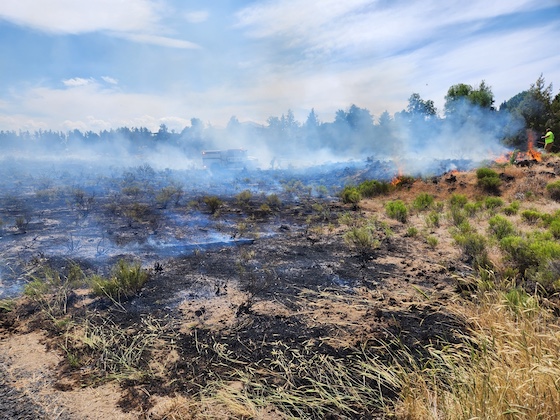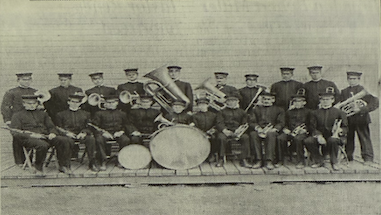Quest for Blue Bucket Mine led ‘suckers’ to actual riches
Published 12:00 am Wednesday, February 1, 2017

- At the spot in the Deschutes River where this bridge is today, members of Stephen Meek’s wagon train built a pulley system to get people and wagons across the river.(Lostwagonman/Wikimedia/Submitted photo)
Oregon, like other states, has an official state bird (western meadowlark), animal (beaver), tree (Douglas fir), gemstone (sunstone) and so forth.
But if the state were going to designate an official state legend, it could do a lot worse than to designate the story of the Lost Blue Bucket Mine.
The Lost Blue Bucket Mine is a story from the early days of the Oregon Trail. It’s probably completely untrue — but then again, maybe it’s not … and its very existence as a myth changed Oregon history in several important ways.
The legend’s backstory
Back in 1845, a big party of emigrants was moving west along the Oregon Trail when members started hearing rumors about Native Americans planning to attack in the Blue Mountains. While they were wondering what to do, mountain man Stephen Meek told them he could lead them on a “cut-off route” over land, around the Blue Mountains to safety. Some 200 wagons’ worth of people took him up on it, and they branched off from the Oregon Trail at Vale and headed into the Oregon High Desert.
The venture was a disaster. The going was very difficult, and it soon became clear that Meek, although he’d been through Eastern Oregon a time or two, hadn’t taken very good notes. When he arrived at the alkali lake country, the changes in drought conditions had rendered the whole landscape unfamiliar to him.
Conditions went from stressed to desperate. And then people started dying.
Finally the party split up, with one going north and the other continuing west. Eventually both parties found the Deschutes River and followed it north to the Columbia, where they rejoined the regular trail. Both parties, by this time, were exhausted, out of supplies (or nearly so) and noticeably depleted in numbers. At least 23 of them died, probably more, and many more arrived in The Dalles in such weakened condition that they didn’t survive the subsequent winter.
By that time Meek himself was nowhere to be found. Meek, after hearing a credible report that a grieving father who had lost two children to the hardships of the trail was now coming after him with murder in mind, slipped away from the wagon train in the dark of night.
But along the trail, just after the party split into two groups, members of one of the two apparently found the Blue Bucket Mine.
The Legend
According to the legend, shortly after the party split, one of the groups was camping for the night near the edge of a river or big creek — possibly the John Day.
A group of the children from the party went down to the river and when the children came back up, they brought with them an assortment of strangely heavy yellow pebbles in the bottom of their blue graniteware bucket. The riverbed was full of the things — so many that you could remove them with a shovel.
The adults in the party found these pebbles very interesting. One of them whacked one with a hammer on a wagon tire, and it mashed flat. Another figured out that these funny rocks made great fishing sinkers, and with their help they were able to get plenty to eat that night for the first time in a long time.
Then it came time to break camp, and the kids wanted to bring the funny yellow rocks with them as souvenirs.
Nothing doing, said the grown-ups. The oxen were already starving and barely pulling their weight; the whole wagon train was in imminent danger of exhaustion; there was no room for extra toys.
And so back into the river went the strange yellow pebbles, and on pressed the hard-pressed party — to The Dalles and eventually to the Willamette Valley, where they thought little more about the strangely heavy yellow pebbles in the blue water bucket until three years later, in 1848, when the California Gold Rush got started. And only then did they realize that they had camped next to a vast fortune in gold nuggets. If only they knew where that campsite was, they could go back and. …
Now, the “red flags” on this legend are legion. First of all, the idea that nobody in the party would have recognized the nuggets as gold even after one had been mashed on a wagon tire is highly suspect; remember, this was an age when people sometimes had to bite gold coins to verify that they were real.
Secondly, even if they had failed to recognize the pebbles as gold, wouldn’t someone have brought some of them along as fishing tackle?
And why are there no names associated with this story? Sure, the people involved could have tried to keep quiet about it, hoping to go back and cash in; but there were two or three years in which they supposedly had no idea what they’d found, and their unusually difficult Oregon Trail experience would have been a frequent topic of conversation with their new neighbors during that time. How is it that we don’t know who they were? And how likely is it that those kids wouldn’t have slipped a pebble or two into a pocket?
So there’s pretty good reason to believe this story is, if not outright falsehood, at least greatly and imaginatively “augmented.” But regardless of its “truthiness,” it had a dramatic impact on the state’s history.
The legend’s results
In 1861, about a dozen years after the California Gold Rush broke out, a man named J.L. Adams showed up in Portland bragging that he’d found the Lost Blue Bucket Mine and claiming he was recruiting a party to help him work it. Most Portlanders didn’t need to be asked twice. In a jiffy Adams had 58 men ready to go.
The problem was, it quickly became obvious that he wasn’t leading them anywhere in particular. He’d stop at promising looking creeks to shake some gravel around in his pan, and if he found a little he’d poke around there for days. In other words, he was acting like a man prospecting for a gold deposit, not a man who’d found a huge one and was on his way back to work it.
Finally, some other members of the party, grown suspicious, collared him and demanded answers. Faced with a hangman’s noose, he confessed: He’d wanted to prospect in the Blue Mountains with a large enough party to fend off any hostile Native Americans, and had made up the whole story as a scheme to recruit that party.
There followed a lively debate over whether or not to kill him. Some of the men he’d recruited had left crops rotting in the ground and land claims unproved-up to come with him on this sure-thing adventure, and they were now left completely twisting in the wind — a metaphorical circumstance that they were now eager to replicate for Adams with a rope and a stout tree.
In the end, the volunteers decided not to kill him. Instead, they took everything but his clothes, kicked him out of camp and started for home.
On the way, they crossed China Creek. This being a gold prospecting party, they didn’t fail to dip their pans in its waters and sling some gravel around … and when they did, they quickly realized they’d hit gold. Lots of it. It wasn’t the Blue Bucket Mine, but it was a big enough strike for everyone to stake a lucrative claim — even Adams, who had been following the party scavenging food from camp leftovers.
The little tent camp that quickly grew up around the strike became a town, which was named Auburn.
The town of Blue Bucket has yet to be platted. Is it still out there, somewhere in the mountains of northeast Oregon, waiting for a weekend adventurer, elk hunter or fly fisherman to stumble upon it? Have subsequent floodwaters covered all the yellow pebbles with silt yards deep? Or did some crazy lonely prospector find it, mine it secretly and disappear?
Let’s face it: We’ll never know. The one thing we do know is that generations of Oregonians have shared and appreciated and wondered about this story around campfires and over dinner tables for the past 170 years. And we know, too, that people looking for it have made history — and would not have done so had it not been for this bit of folklore.
As a historical account, it’s pretty sketchy. But as a piece of oral folklore, this story’s place in state history is assured and well deserved.
(Sources: Friedman, Ralph. Tales Out of Oregon. Sausalito, Calif.: Pars Publishing, 1967; Clark, Keith & al. Terrible Trail: The Meek Cutoff, 1845. Bend: Maverick, 1966)
Finn J.D. John teaches at Oregon State University and writes about odd tidbits of Oregon history. For details, see http://finnjohn.com. To contact him or suggest a topic: finn2@offbeatoregon.com or 541-357-2222.






